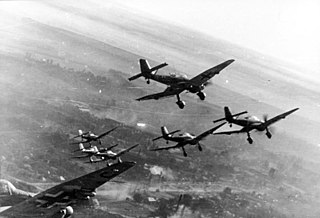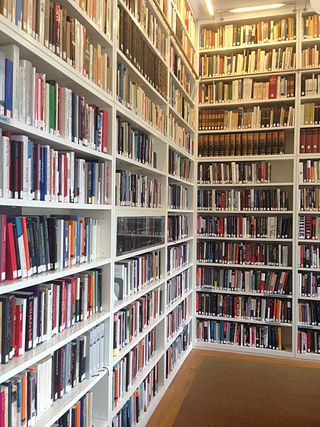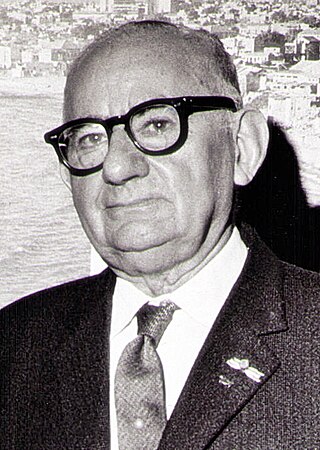
The European theatre of World War II was one of the two main theatres of combat during World War II, taking place from September 1939 to May 1945. The Allied powers fought the Axis powers on both sides of the continent in the Western and Eastern fronts. There was also conflict in the Scandinavian, Mediterranean and Balkan regions. It was an intense conflict that led to at least 39 million deaths and a dramatic change in the balance of power in the continent.
This is a selected bibliography and other resources for The Holocaust, including prominent primary sources, historical studies, notable survivor accounts and autobiographies, as well as other documentation and further hypotheses.

The Casablanca Conference or Anfa Conference was held in Casablanca, French Morocco, from January 14 to 24, 1943, to plan the Allied European strategy for the next phase of World War II. The main discussions were between US President Franklin Roosevelt and British Prime Minister Winston Churchill. Stalin could not attend. Key decisions included a commitment to demand Axis powers' unconditional surrender; plans for an invasion of Sicily and Italy before the main invasion of France; an intensified strategic bombing campaign against Germany; and approval of a US Navy plan to advance on Japan through the central Pacific and the Philippines. The last item authorized the island-hopping campaign in the Pacific, which shortened the war. Of all the decisions made, the most important was the Allied invasion of Sicily, which Churchill pushed for in part to divert American attention from opening a second front in France in 1943, a move that he feared would result in very high Allied casualties and not be possible until 1944.

Arthur Szyk ; June 3, 1894 – September 13, 1951) was a Polish-born Jewish artist who worked primarily as a book illustrator and political artist throughout his career. Arthur Szyk was born into a prosperous middle-class Jewish family in Łódź, in the part of Poland under Russian rule in the 19th century. An acculturated Polish Jew, Szyk always proudly regarded himself both as a Pole and a Jew. From 1921, he lived and created his works mainly in France and Poland; in 1937 he moved to the United Kingdom. In 1940, he settled permanently in the United States, and was granted American citizenship in 1948.

The Holocaust Memorial Center in Farmington Hills, Michigan, near Detroit, is Michigan's largest Holocaust museum.

The Wiener Holocaust Library is the world's oldest institution devoted to the study of the Holocaust, its causes and legacies. Founded in 1933 as an information bureau that informed Jewish communities and governments worldwide about the persecution of the Jews under the Nazis, it was transformed into a research institute and public access library after the end of World War II and is situated in Russell Square, London.
The historiography of World War II is the study of how historians portray the causes, conduct, and outcomes of World War II.

Gerhard Ludwig Weinberg is a German-born American diplomatic and military historian noted for his studies in the history of Nazi Germany and World War II. Weinberg is the William Rand Kenan Jr. Professor Emeritus of History at the University of North Carolina at Chapel Hill. He has been a member of the history faculty at UNC-Chapel Hill since 1974. Previously he served on the faculties of the University of Michigan (1959–1974) and the University of Kentucky (1957–1959).

The Ghetto Fighters' House is a Holocaust museum founded in 1949 by members of Kibbutz Lohamei Hagetaot. It is located in the Western Galilee, Israel, on the Coastal Highway between Acre (Akko) and Nahariya.
Holocaust victims were people targeted by the government of Nazi Germany based on their ethnicity, religion, political beliefs, disability or sexual orientation. The institutionalized practice by the Nazis of singling out and persecuting people resulted in the Holocaust, which began with legalized social discrimination against specific groups, involuntary hospitalization, euthanasia, and forced sterilization of persons considered physically or mentally unfit for society. The vast majority of the Nazi regime's victims were Jews, Sinti-Roma peoples, and Slavs but victims also encompassed people identified as social outsiders in the Nazi worldview, such as homosexuals, and political enemies. Nazi persecution escalated during World War II and included: non-judicial incarceration, confiscation of property, forced labor, sexual slavery, death through overwork, human experimentation, undernourishment, and execution through a variety of methods. For specified groups like the Jews, genocide was the Nazis' primary goal.
Holocaust trivialization refers to any comparison or analogy that diminishes the scale and severity of the atrocities committed by Nazi Germany during the Holocaust. The Wiesel Commission defined trivialization as the abusive use of comparisons with the aim of minimizing the Holocaust and banalizing its atrocities.
The following outline is provided as an overview of and topical guide to World War II:

This is a timeline of events that occurred during World War II in 1943.

The Soviet re-occupation of Latvia in 1944 refers to the military occupation of Latvia by the Soviet Union in 1944. During World War II Latvia was first occupied by the Soviet Union in June 1940, then was occupied by Nazi Germany in 1941–1944, and after which it was re-occupied by the Soviet Union.
Kenneth William Rendell is the founder of The International Museum of World War II in Boston, and an American dealer and expert in historical documents.
Apocalypse: The Second World War (2009) is a six-part French documentary by Daniel Costelle and Isabelle Clarke about the Second World War. The music of the documentary was composed by Kenji Kawai.
The diplomatic history of World War II includes the major foreign policies and interactions inside the opposing coalitions, the Allies of World War II and the Axis powers, between 1939 and 1945.

Maurice Frankenhuis was a Jewish Dutch businessman, historian, researcher, author, collector, numismatist, Holocaust survivor, and philanthropist. He documented the history of World War I and World War II through his family's experiences in the Netherlands and subsequent internment in two concentration camps. Throughout the ordeal he built a collection of memorabilia and authored a firsthand account to the Holocaust of Dutch Jewry. He dedicated himself to educating about the Holocaust, and preserve a record of history for future generations including donations of his collections of medals and posters to various museums around the world, and writing his personal memoirs, observations and commentary on world affairs after the war.
The foreign policy of the United States was controlled personally by Franklin D. Roosevelt during his first and second and third and fourth terms as the president of the United States from 1933 to 1945. He depended heavily on Henry Morgenthau Jr., Sumner Welles, and Harry Hopkins. Meanwhile, Secretary of State Cordell Hull handled routine matters. Roosevelt was an internationalist, while powerful members of Congress favored more isolationist solutions in order to keep the U.S. out of European wars. There was considerable tension before the Attack on Pearl Harbor in December 1941. The attack converted the isolationists or made them irrelevant. The US began aid to the Soviet Union after Germany invaded it in June 1941. After the US declared war in December 1941, key decisions were made at the highest level by Roosevelt, Britain's Winston Churchill and the Soviet Union's Joseph Stalin, along with their top aides. After 1938 Washington's policy was to help China in its war against Japan, including cutting off money and oil to Japan. While isolationism was powerful regarding Europe, American public and elite opinion strongly opposed Japan.
The international Jewish conspiracy or the world Jewish conspiracy has been described as "one of the most widespread and long-running conspiracy theories". Although it typically claims that a malevolent, usually global Jewish circle, referred to as International Jewry, conspires for world domination, the theory's content is extremely variable, which helps explain its wide distribution and long duration. It was popularized in the late nineteenth and early twentieth century especially by the antisemitic forgery The Protocols of the Elders of Zion. Among the beliefs that posit an international Jewish conspiracy are Jewish Bolshevism, Cultural Marxism, Judeo-Masonic conspiracy theory, White genocide conspiracy theory and Holocaust denial. The Nazi leadership's belief in an international Jewish conspiracy that it blamed for starting World War II and controlling the Allied powers was key to their decision to launch the Final Solution, which culminated in the Holocaust.










